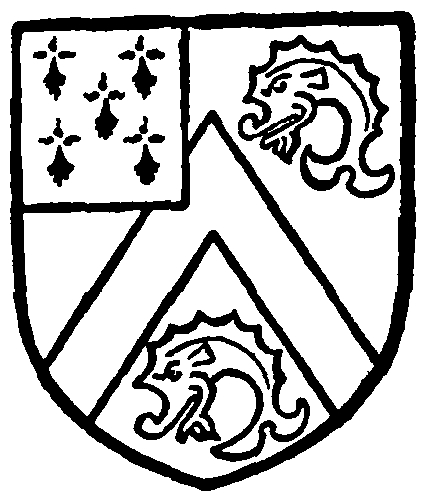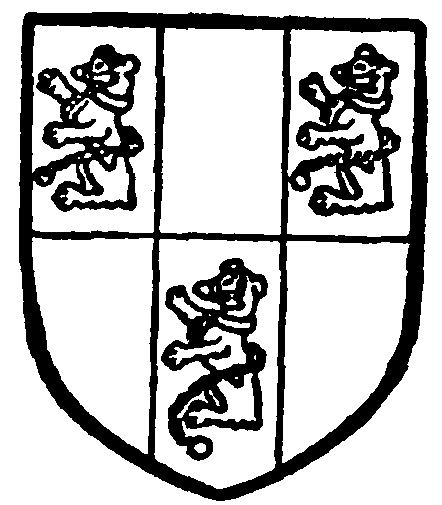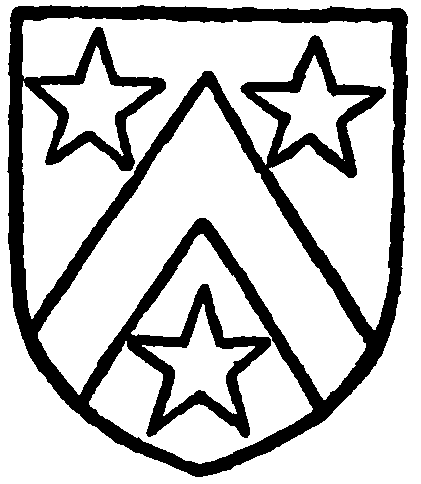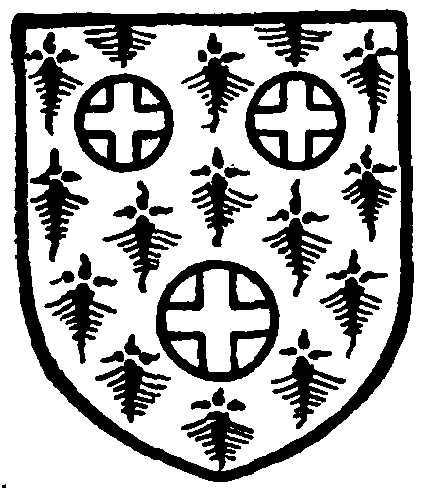Pages 411-414
A History of the County of Hampshire: Volume 4. Originally published by Victoria County History, London, 1911.
This free content was digitised by double rekeying. All rights reserved.
In this section
WHERWELL with WESTOVER
Werewelle, Warwelle (xi cent.); Hwerewelle, Wharewell, Hwherewelle, Thwerewelle (xiii-xiv cent.); Whorwell, Worwell (xvi cent.); Horwell (xvi-xvii cent.); Whorwell (xvii cent.); Harwell, Whirwell (xviii cent.).
The parish of Wherwell is divided from Longparish by the old Roman road which ran through the heart of Harewood Forest from Winchester to Cirencester. Along the eastern and south-eastern boundary flows the Test, the vicinity of which is liable to floods. The mean height varies in different parts of the parish from 200 ft. to 300 ft. The soil is part light gravel, part heavy gravel and part white loam. The subsoil is chalk and there are several chalk pits. The chief crops are wheat, barley, oats, turnips and grass. The total area of the parish is 3,633 acres, comprising 2,111½ acres of arable land, 701 acres of permanent grass and 511 acres of woods and plantations. (fn. 1) Some 34 acres are covered by water. To the north the parish runs wedgewise through the heart of Harewood Forest and includes Wismore Copse, Popple Hill Copse, Hartway Copse, Park Brow Copse and Hassock Copse. There is a station at Wherwell on the Hurstbourne and Fullerton branch of the London and South Western Railway, and at Fullerton is the junction of that and the Andover and Redbridge branches. The village is situated mainly between the railway line and the most northern stream of the Test, beyond which, and bridging one of the streams, is Wherwell Priory. The tithing of Fullerton lies 1½ miles to the southwest on the River Anton. Westover is 2 miles due west of Wherwell, Mount Pleasant a quarter of a mile to the north and Dublin Farm half a mile to the north-east. At the south-west extremity of the parish, where it becomes a narrow strip between Longstock and Goodworth Clatford, are Rowberry and Nettlebank Copses.
The road from Andover to Winchester passes through the village and a branch of the same road passes through Fullerton. From Fullerton a road runs north-west past Redrice Park and through Abbotts Ann, crossing that from Andover to Stockbridge just south of Westover.
Among place-names in Wherwell found in early documents are: 'La Whire,' 'La Burstelade,' 'Waddune,' 'La Stapele,' 'La Flodweye,' 'La Cline,' 'Foracre,' 'Sotingor,' 'La Medscherde.' (fn. 2)
Manor
When in 1002 Ethelred confirmed his mother's (fn. 3) foundation of Wherwell Abbey the property of that house in the vicinity of WHERWELL consisted of 70 mansae, (fn. 4) and in Domesday Book it is said to hold the whole vill in which the abbey stands. (fn. 5) In 1207 John granted the community certain liberties, and the right of an annual fair at Wherwell on the day of the dedication of the church, the day before and the two days following, provided it should not harm the neighbouring fairs, (fn. 6) and in 1215 a letter to that end was directed to the sheriff. (fn. 7) The right of holding a market every Wednesday at her manor of Wherwell was granted to the abbess in 1267, (fn. 8) but a few months later she was attached for not appearing to answer a charge of holding a market to the hurt of the king's free market at Basingstoke. (fn. 9) In 1331 the community had a grant of free warren over its demesnes of Wherwell and elsewhere, (fn. 10) which was confirmed in 1378. (fn. 11) In 1291 the manor was worth £59 13s. 6d., (fn. 12) and it continued in possession of the monastery until the Dissolution.
Thomas West ninth Lord De La Warr was not only in the royal favour for his furtherance of the divorce, but he was also lord of five Sussex manors which Henry wished for his own, and proposed to take in exchange for other lands. Accordingly, in November 1539, Lord De La Warr wrote to Cromwell urging him to use his influence to get him the Wherwell estates.
'I would gladly have the said nunnery because it stands wholesomely, in the country where I was born, and my wife has no house to dwell in if I should die before her; and this is but a reasonable house as I hear say. I beg your favour that I may obtain the said abbey before the surveyors of the same come to the king, for fear he should grant it to another. Trusting if I get it, that the king will discharge all leases and fees going out of it, as I shall do to his grace in Halfnakyd.' (fn. 13)
A few days later Wherwell was surrendered. (fn. 14) Cromwell had more than once noted John Kingsmill as a candidate for the property, (fn. 15) but in the following March the site of the monastery, the manor and advowson, six manors adjacent (fn. 16) and other neighbouring property of the dissolved house were granted to Lord De La Warr for the rent of £137 3s. 8d. and the coveted Sussex lands. (fn. 17) In 1544 the new lord of Wherwell bought the lead and bells of the monastery for £100. (fn. 18) On his death without issue in 1554 the baronies of De La Warr and West fell in abeyance between the daughters of Sir Owen West, his brother of the half-blood. During his lifetime he had taken his nephew William son of Sir George West of Warbleton into his house and adopted him as his heir. William, however, too eager for his inheritance, was discovered to be scheming to poison his uncle, and in 1549 he was deprived of all rights to honours and estates by Act of Parliament. (fn. 19) In 1570, however, he became Lord De La Warr by a new creation and died in 1595 seised of the family manors. (fn. 20) His son obtained the precedency of the ancient barony.
In 1605 because of nonpayment of a bond given on the premises to Elizabeth by William the newly created Lord De La Warr all these estates in Wherwell Hundred were seized into the hands of the Crown and, with certain exceptions, granted to Sir John Crofts till the sum should be paid. (fn. 21) The exceptions were all trees, wood, underwood, mines and quarries, together with the advowson of the prebend or rectory of Wherwell and all tithes and profits, which were granted in 1625 to Sir Thomas Edmonds, treasurer of the royal household. (fn. 22)

West, Lord De La Warr. Argent a fesse dancetty sable.
In 1616 Thomas West, third baron, had a licence to sell these manors, (fn. 23) which none the less remained in his descendants' hands until 1695. Fourteen years later Cecily Dowager Lady De La Warr was discharged £278 2s. 6d. arrears of rent for the site of the monastery of Wherwell. (fn. 24) During the Civil War there was a good deal of fighting in this part of the shire; and in 1645 Lord De La Warr was petitioning the House of Lords for protection. His estate in the county of Southampton, he complained, had sustained much damage by the quartering of both armies upon his tenants and the cutting down of his woods by the soldiers; and now it was intended to make his house at Wherwell into a garrison contrary to the order for the protection of peers' houses. This was likely to spoil the house and to be of little advantage to the State by reason of the hills which adjoined it. (fn. 25)
In 1695 John (West) sixth Lord De La Warr sold those Hampshire lands which his ancestors had had from Henry VIII to Edmond Boulter of London. (fn. 26) Edmond Boulter died in February 1709 possessed of estates in several shires. By his will proved in the following March he left his manors in Wherwell and Goodworth Clatford—he had already disposed of the neighbouring manors—to his nephew John Fryer, 'pewterer in the parish of St. Bennet Gracechurch, in the City of London.' (fn. 27) The new lord of Wherwell, an eminent City merchant and an alderman, was created a baronet in 1714. Dying in 1726 without surviving male issue, he bequeathed his Hampshire manors equally among his three daughters, Bithiah Brassey, Susannah Fryer and Delicia Fryer. (fn. 28) On the death of Susannah in October 1731 (fn. 29) her inheritance passed to her sister of the whole blood, Bithiah wife of Nathaniel Brassey of Lombard Street. In 1742 (fn. 30) Delicia Fryer, the youngest co-heir, married Joshua Iremonger, who thus became lord of one-third part of the manors of Wherwell and Goodworth Clatford. He purchased the other two-thirds from Nathaniel Brassey in February 1743, (fn. 31) so reuniting the property, which is now in the possession of his descendant, Mr. William Henry Iremonger.

Fryer, baronet. Sable a cheveron between three dolphins swimming argent and a quarter ermine.

Iremonger of Wherwell. Sable a cheveron or between three boars passant argent with three hawks' heads razed sable on the cheveron.
By the custom of the manor of Wherwell copyhold lands might be granted for three lives in possession or for one life in possession and two in reversion and no more. (fn. 32)
There were three mills worth 27s. 6d. at Wherwell at the time of the Domesday Survey. (fn. 33) Among the good deeds of the Abbess Eufemia (1226–57) enumerated in the cartulary was the building of 'a new mill, some distance from the hall,' constructed 'with great care, in order that more work than formerly might be done therein for the service of the house.' (fn. 34)
At the present time there is a mill close by the church and another at Fullerton. In 1730 a water grist-mill with its appurtenances, in Wherwell, was the object of a conveyance between George Luke and William Hunt. (fn. 35)
WESTOVER is not mentioned as a separate manor in Domesday, nor does it occur in 1228 among the possessions of Wherwell Abbey in the privilegium of Gregory IX. (fn. 36) It was one of the manors, however, granted to Thomas West Lord De La Warr by Henry VIII, from the property of the dissolved monastery.
After the Wests parted with the property it again disappears. It is named as a manor in the indenture made on the sale of the Wherwell property by Lord De La Warr to Edmond Boulter in 1695, (fn. 37) but there seems to be no record of a subsequent sale. Certainly it had not been sold in 1706, when, in an indenture drawn up for creating new trustees of this property, the manors already disposed of are enumerated. (fn. 38) Boulter died early in 1709 and there is no mention of Westover in his will, but he bequeathed all his manors in Wherwell and Goodworth Clatford to his nephew John Fryer. (fn. 39) It is probable, therefore, that it became merged in Wherwell about this date, and has continued to descend with that manor.
In 1773 Robert Dowling and others assigned to Joshua Iremonger all manner of tithes in Westover, and other premises, for a term of three lives. (fn. 40)
At the time of the Survey the manor of FULLERTON was held by Hyde Abbey, (fn. 41) to which, as the 'vill of Wherwell,' it had been bequeathed by King Edred, who died in 955. (fn. 42) According to Thomas Rudborne, who wrote in the 15th century, Wherwell was among the lands escheated from Hyde by William the Conqueror, but this statement is, of course, proved false by the Domesday entry. (fn. 43) At the taxation of Pope Nicholas, Fullerton and the neighbouring manor of Leckford, wherewith it is ever to be found coupled, were valued among the temporalities of Hyde Abbey at £15 17s. 3d. (fn. 44) In the following century the abbey obtained licence from Adam of Orlton, Bishop of Winchester (l333–45), to celebrate divine service in the oratory of the manor of Fullerton. (fn. 45) In 1388, since it was found by inquisition that this manor with that of Abbotts Ann and other premises had from time immemorial belonged to the convent separately from the abbot's portion, the king granted that such premises should be exempt from seizure in times of voidance, saving only the advowsons to the Crown. (fn. 46)
Fullerton remained abbey land until the Dissolution. In 1541 Augustine de Augustinis, a Venetian and physician to the king, had a life grant of the manor and tithes of hay in Fullerton, together with other lands taken from religious houses, in lieu of certain annuities. (fn. 47) In July 1545 he was granted in fee the reversion of these lands and rights, (fn. 48) but in the following September he and his wife Agnes had a licence to alienate Fullerton and other premises to Lord Chancellor Wriothesley. (fn. 49) However, in 1549 the manor was conveyed to John Mill and John his youngest son by Thomas Pace, John Capleyn and Thomas Goddarde, a merchant of Southampton, to be held of the king in chief by the service of one-fortieth part of a knight's fee and a rent of 29s. 8d. (fn. 50) This John Mill the elder, a cadet of the Mills of Greatham (co. Sussex), died in 1551, (fn. 51) and was duly succeeded by John the younger, whose marriage with Catherine Lewkenor daughter and co-heir of Sir Roger Lewkenor brought him Camois Court, in Sussex. His grandson John Mill, son of Lewkenor Mill, was created a baronet in 1619 and died in 1648, when the manor of Fullerton descended to Thomas Mill, his second son and uncle of the second baronet. (fn. 52) Exactly when the Mills parted with the manor has not been ascertained, but by 1717 it was in the hands of John Chetwynd, (fn. 53) who four years later conveyed it to his brother Walter Viscount Chetwynd of Bearhaven and Edward Carteret. (fn. 54) This John Chetwynd, who succeeded as second viscount in 1736, married Hester only daughter and heir of Richard Kent of the Close, Salisbury and Katherine his wife. It seems that this match brought him Fullerton; for when returned as M.P. for Stockbridge in 1727 he was described 'as of Fullerton' (fn. 55) and in an indenture of 1730 (fn. 56) another of two years earlier is quoted by which trustees were created of this manor and all other premises late of Hester Chetwynd and now of John Chetwynd in Fullerton and Wherwell. In 1730 John Chetwynd sold the manor and its appurtenances to William Heathcote of Hursley (co. Hants), (fn. 57) created a baronet in 1733. In 1825 Sir William Heathcote, fifth baronet, was vouched as warranty in a recovery between Samuel Foster and George Frere. (fn. 58) The Heathcote property was sold in 1892 to Mr. William Cory, the present lord of the manor. (fn. 59)

Mill, baronet. Six pieces argent and sable with three bears sable in the argent having their chains and muzzles or.

Chetwynd. Azure a cheveron between three molets or.

Heathcote. Ermine three roundels vert with a cross or upon each.
During the episcopate of William Edendon (1346–66) licence was granted to Isabel Cormeilles to celebrate divine service in the oratory of the house called TALLEMACHE in the vill (villula) of Wherwell. (fn. 60)
Church
The church of ST. PETER AND HOLY CROSS consists of a chancel 26 ft. 6 in. by 16 ft., nave 49 ft. 3 in. by 18 ft. 8 in., with north and south aisles 11 ft. wide, north vestries, timber south porch, and a bellturret over the west end of the nave.
The building is entirely modern and was erected on the site of an old church in 1856. Two prints in the choir vestry show what this church was like in 1830. It then consisted of a nave and north aisle continued into chancel and north chapel. Over the west end of the aisle was a low wooden bell-turret, and on the south of the nave there was a rough timber porch. All the windows of the nave had cinquefoiled lights with flat heads. The west window of the aisle had three cinquefoiled lights and a cinquefoiled label. To the south of this was a small window of two plain pointed lights. Three angle buttresses show, one in the centre of the east wall and two on the south wall.
In the churchyard are several old stones coming either from the earlier church or else from Wherwell Priory, which was situated close by on the south side. At the west end of the church are a stone coffin without a lid, a mullion of a 13th-century window, and half of a flat four-centred arch, c. 1540, with Renaissance ornament and a defaced shield in the spandrel.
Against the vicarage wall at the east end of the churchyard is an altar tomb to Sir Owen West of good early Renaissance detail, undergoing a slow destruction by weather and ivy. The inscription in two cartouches reads in the first, 'Of yowre charite pray for the soolles off Syr Owen Weste Knyte and Mary his wiffe who died' | in the second, 'the which died the 18 day of July anno domini 1551.' On either side are shields, one often quarters, thus: (1) a fesse dancetty; (2) crusilly fitchy a lion; (3) per saltire four martlets; (4) a bend engrailed; (5) barry and a chief paly and paly an escutcheon with three piles; (6) as (2); (7) three lions' faces jessant de lis; (8) as (5); (9) as (3); (10) as (4). The second has 1, 2, 6 and 7, and coat one; a crescent for difference on both. Near this is a modern brick recess in which is placed the recumbent figure of a nun. The arch of this recess is apparently of early 14th-century date and is of stone with eight foils and rests on short attached shafts with moulded capitals and bases.
Built into this same wall is a stone with two shallow arched recesses of late 13th-century date, containing two groups of figures, one showing the Harrowing of Hell and the other, much damaged, two figures, the smaller with hands raised in fear or astonishment.
Near this stone is another old one carved with a four-leafed flower. Another stone in this wall represents an angel and a four-leafed flower.
There are several loose stones of various dates, one a 13th-century corbel made from the shaft of a Saxon cross, with interlacing patterns on two sides, and two others form apparently bases of niches or the like of 15th-century date, bearing shields inscribed 'Thos. be[..]ow' and 'Iha[..]e be[..]ow,' perhaps for Johannae, with a Tudor rose between.
There is also a small piece of a. stone coffin slab on which part of a marginal inscription remains: dictus fructus and eterne, amen, and in the gable of the vicarage stable is inserted a 14th-century gable cross.
The bell-turret contains five bells, the treble being by Warner, 1858, and the other four by William and Robert Cor, 1707.
The plate consists of a silver chalice and paten (probably of local make) of circa 1650, given by Richard Finch Humphrey, another silver paten of 1662, (fn. 61) two glass cruets, a plated flagon and two plated alms plates.
The registers are bound up in three books, the first containing baptisms, marriages and burials mixed from 1634 to 1708. The second book contains mixed entries from 1708 to 1742 and then baptisms from 1782 to 1813, marriages 1783 to 1814, and burials 1777 to 1813. There is also a brief in this book dated 1724. A third book, which really belongs in the middle of the second, contains mixed entries from 1742 to 1771.
Advowson
The Abbess and convent of Wherwell presented to the prebend of Wherwell until the Dissolution, when the advowson was granted to Lord De La Warr, (fn. 62) Richard Parkhurst, the resigning rector and prebendary at that time, receiving an annuity of £30. (fn. 63) In February 1545 a second grant of the advowson was, by an error, made to one John Eyer, (fn. 64) who in the following August had his purchase money returned to him by a decree of the Court of Augmentations. (fn. 65)
When he sold the manor to Edmond Boulter in 1695, John sixth Lord De La Warr sold also the advowson of the prebend of Wherwell, (fn. 66) which was vested in the lords of the manor until its suppression.
At the beginning of the 17th century, when Lord De La Warr's Hampshire estates were forfeited to the Crown, the advowson of the prebend or rectory of Wherwell with all tithes and profits was granted to Sir Thomas Edmonds, treasurer of the royal household. (fn. 67)
Matthew Nicholas, Secretary Nicholas's brother, afterwards Dean of St. Paul's, was chosen prebendal rector of Wherwell in 1637. There seems to have been some dispute as to his election, for immediately after his induction he wrote to his brother Edward that there remained nothing else to be done (if the young Lady De La Warr did not prosecute her pretended title) than to thank his noble patron; that the old Lady De La Warr had withdrawn her caveat and the young lady sent in no man at the day appointed by the bishop to show her title, whereupon the bishop had taken a bond of £200 of the writer to save him harmless and had given him institution. (fn. 68) In 1686 John West, although a layman, was presented to the prebend by Lord De La Warr, and the king granted a dispensation for his institution and induction. (fn. 69)
In 1852 the prebend of Wherwell was declared ar ecclesiastical rectory without cure of souls, and in 1857 the prebendary, the Rev. Thomas Lascelles Iremonger, resigning, it was suppressed. (fn. 70) Since that date the vicarage has been in the gift of the lords of the manor.
There is a Wesleyan chapel in the parish, erected in 1846, and a Primitive Methodist chapel, erected in 1887.
Charities
In 1691, as appears from a stone tablet in the church, Philadelphia Whitehead purchased from John Lord De La Warr 12s. a year for ever out of the yearly rent of the White Lion Inn to be paid to twelve old men and women at Christmas. The annuity is paid by Mr. W. H. Iremonger, the owner, and duly applied.


